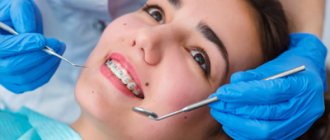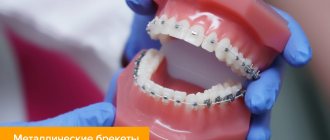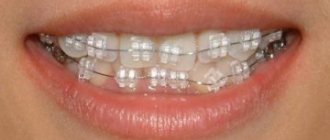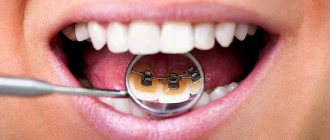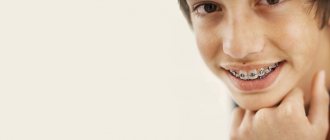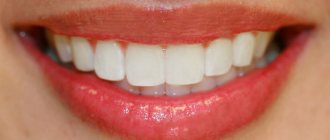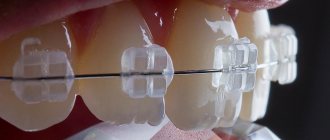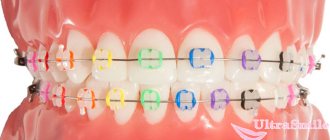Metal braces, made of steel or titanium alloy, can withstand high mechanical loads. Durable metal structures help correct complex dental pathologies, are not subject to staining and practically do not irritate the mucous membrane. The design of the bracket includes a body, a base, a groove and wings. In passive self-ligating brackets, the lid closes, turning the slot into a tube and holding the archwire. In ligature structures, the arc is fixed in the groove using elastic or wire ligatures. The small forces generated by orthodontic wires gradually move the upper and lower teeth into the correct position. If necessary, the doctor can install elastics, springs and chains into the subligature space of the bracket limited by the wings. These additional elements help speed up treatment and provide the necessary vectors of orthodontic forces.
Information verified by Ormco Russia Product Manager, Alisa Sirotko.
Damon Q braces on typodont without ligatures
Metal braces are small in size compared to ceramic braces. Installing metal devices facilitates the hygiene process; the material is not subject to corrosion and does not change color. The small forces created by the archwires consistently move the teeth within the jaw bone.
Passive self-ligating metal braces Damon Q2 and Damon Q are made of 17-4 stainless steel. The bracket cover provides minimal friction to the archwire and controls tooth rotation. In the grooves of metal braces without ligatures, the arch glides smoothly without slowing down the treatment process. Metal braces with ligatures include, for example, Mini Diamond and Orthos. Clinical tests confirm the resistance of steel braces to the forces of arches, springs and elastic rods.
Damon Q on the crown of a tooth
Metal braces on teeth - what are they?
Metal braces are non-removable orthodontic devices for correcting malocclusions and straightening the dentition. The main elements of this design are the locks, which are glued to the enamel of the teeth, as well as the arch connecting them. Ligature devices additionally use fasteners made of rubber or wire - ligatures that secure the arc in the grooves of the locks.
The most common metal for making braces is medical stainless steel. This is a strong, durable, inexpensive material, but the patient may experience an allergic reaction to it. As an alternative, manufacturers offer hypoallergenic alloys of nickel and titanium, gold, platinum or plating of precious metals.
The therapeutic effect is due to the physical properties of the metal from which the arc is made. After fixation in the locks, under the influence of body temperature, it strives to return to its original anatomically correct shape, gradually moving and aligning the teeth. Wearing the device for a year or two allows you to correct defects of any complexity.
The optimal period for this correction method is considered to be adolescence, starting from 12 years. At this time, the tissues of the maxillofacial apparatus are most pliable, so a lasting result is achieved quickly. You can install metal braces earlier - at 7-9 years old, if indicated. As a rule, children have partial “24” systems installed (on incisors and first molars).
More information about braces for children in our article.
Braces are a design for correcting malocclusion
Installing metal braces for adults is no less effective, although treatment may require more time.
Mandatory conditions for successful correction are regular visits to the orthodontist to adjust the structure, proper brushing of teeth, and long-term use of retainers or mouth guards after removal.
What are the benefits of early treatment?
When correcting a bite, in most cases the patient will go through a stage where his upper incisors will (temporarily) stick out forward. Such protruding teeth, especially in children, are most susceptible to injury from falls and bruises, and besides, they are not very aesthetically pleasing. Early treatment, for example, avoids this situation.
Also, early correction of the bite allows the orthodontist to positively influence the growth of the jaw, the width of the dental arches, improve the aesthetics and self-esteem of the child, and eradicate bad habits. The process of eruption of permanent teeth is also improved by creating space for them to erupt (if there is a lack of it), the total time of orthodontic treatment and its cost are reduced, and diction is improved. We hope that our article on the topic: Installation of braces reviews was useful to you!
Sources:
1. “Orthodontics. Textbook for dentists" (Kutsevlyak V.I.), 2. American Association of Orthodontists (USA), 3. National Library of Medicine (USA), 4. "Conceptual orthodontics" (Williams Stefan), 5. "Fixed orthodontic technique" (Gerasimov S.N.), 6. https://www.realself.com/.
Types of metal braces
More than a hundred years have passed since the appearance of the first orthodontic device similar to a modern one for correcting malocclusion, during which the design was constantly improved. Today, foreign and domestic manufacturers offer different device options, each of which has its own design features, advantages, and disadvantages.
Metal vestibular braces
This is the name given to braces systems that are attached to the outer surface of the teeth. Their advantages include:
- high efficiency - treatment takes 1-2 years (six months for minor defects), pathologies of any complexity can be corrected;
- short adaptation period - no more than 2 weeks;
- quick installation, easy maintenance;
- affordable prices.
The main disadvantage of the vestibular metal brace system is its low aesthetic characteristics. Locks and arches made of metal, especially titanium, are clearly visible on the teeth, so patients often experience psychological discomfort and are embarrassed to smile and talk. However, only external metal braces can minimize the treatment period and correct very complex defects.
The location of the device on the front surface of the teeth sometimes leads to another complication - injury to the structural elements of the mucous membrane of the cheeks and tongue. Installing more compact models of locks or using special silicone wax will help avoid this.
Lingual metal braces
They are considered braces systems for perfectionists or public people who do not want to advertise the fact of orthodontic treatment. Lingual metal braces are attached to the inner surface of the teeth, facing the tongue, and are therefore completely invisible to others. This is their only advantage over vestibular devices, and there are several disadvantages:
- increase in treatment time by 1.5-2 times;
- problems with diction for several weeks after installation;
- risk of tongue injury;
- difficulties in care;
- impossibility of use in difficult cases (with severe crowding of teeth);
- high price.
The last point may be decisive when choosing: lingual structures will cost 8-10 times more than vestibular ones.
Difference Between Lingual and Vestibular Braces
Metal ligature braces
Classic orthodontic treatment, they are distinguished by the presence of a separate fastening element - ligature. The latter is a wire or elastic rubber ring with which the arc is fixed in the grooves of the locks.
Metal ligature braces, due to their rigid fastening, are more effective, reducing treatment time, and also cost less than any analogues. However, there are a number of disadvantages that are important to consider when choosing:
- low aesthetic characteristics - massive locks with ligatures are very noticeable on the teeth;
- high risk of injury to the mucous membrane due to the large size and high profile of braces;
- the need for monthly visits to the orthodontist to adjust the system and replace ligatures.
However, ligature devices are in high demand due to their high efficiency combined with low prices. In addition, manufacturers, in order to improve the appearance of their products, produce multi-colored, shaped rubber fasteners.
Self-ligating metal braces
A special feature of ligature-free brace systems is the presence of built-in clips with locks. This design has several advantages:
- quick installation - the doctor needs significantly less time to fix the arc in the locks;
- rapid adaptation – self-ligating systems have a gentler effect on the teeth, so adaptation is almost painless;
- comfortable wearing - locks with clips have a streamlined shape with smoothed corners, a low profile, so the oral mucosa is less likely to be injured;
- reduction in the number and duration of visits to the doctor - a specialist requires less time to adjust the system, and visiting the orthodontist is enough once every two months.
The higher cost of self-ligating metal brace systems is compensated by the comfort of their use, and design features have little effect on treatment time.
Mini metal braces
This category includes ligature structures with reduced clasps - their surface area is 25-30% lower than that of standard analogues. At the same time, the reliability of fixation on the enamel is not reduced: manufacturers make the supporting surface of the lock in relief and equip it with a reinforcing mesh.
Due to their small dimensions, Mini brace systems are more comfortable to use, as they do not injure the mucous membranes and look quite aesthetically pleasing. The disadvantages include the need for regular monthly visits to the doctor, characteristic of ligature devices.
Adaptation
The adaptation period is one of the most difficult for the patient. Possible problems with diction, toothaches and a feeling of rubbing of the oral mucosa.
Unpleasant sensations appear when chewing food, as well as when clenching the jaws.
The duration of this stage does not exceed a week. If the pain does not go away within 2 weeks, you should contact an orthodontist.
The problem of injury to the mucous membrane is solved by placing special wax on parts of the structure that have a rubbing effect.
Diction disorders occur more often when installing lingual structures. Speech is restored quite quickly without medical intervention.
While wearing braces, you should refrain from eating foods that can damage the structure.
Alternative to metal braces
If you are not satisfied with the aesthetic or functional properties of metal bracket systems, you can choose an analogue from a different material. The table shows the main characteristics of different types of orthodontic structures.
| Metal | Ceramic | Sapphire | |
| Duration of treatment, effectiveness | Minimum, from six months to 2 years. Allows you to correct defects of any complexity | From one and a half years, not suitable for correction of complex pathologies | From 1.5 years, not used to treat complex cases |
| Durability, practicality | Durable and not stained with food coloring | The ceramics of the locks are fragile and require careful handling | Artificial sapphire crystals are fragile |
| Aesthetics | Low | High | Very high |
| Comfort | Possible injuries to the mucous membrane, pain during the adaptation period | The likelihood of injury is low, addiction is easy | Low trauma, quick adaptation |
| Safety | Medical steel can provoke an allergic reaction due to individual intolerance | Ceramics are hypoallergenic | Hypoallergenic |
| Minimum cost without installation (for 1 jaw), in rubles | 14000 | 25000 | 40000 |
Ceramic products are also called metal-ceramic, since the locks are made of ceramics, and the power arc is made of steel.
Which metal braces are better?
Modern metal braces are the best option for quick bite correction. In our clinic, the patient can choose any model, focusing on the duration of treatment, ease of wearing and his own budget.
Metal braces Damon Q
The most popular brand of metal self-ligating braces, produced by Ormco (USA). Damon Q is a ligature-free device of the passive type, in which the arc is not rigidly fixed in the lock, but can move in it. Thanks to this feature, the adaptation process is painless, correction is performed in the most natural way possible. Other advantages of the design include:
- patented SpinTek mechanism, ensuring compactness, strength, and wear resistance of locks;
- installation does not require the removal of dental units; the device also makes it possible to free up space for dystopic teeth;
- ease of use - low risk of injury to the mucous membrane, neutral appearance, ease of care;
- hypoallergenic metal alloy;
- reducing the frequency of visits to the orthodontist to once every 2 months.
The listed advantages have little effect on the cost of products. The cost of installation per jaw is only 1.5 times higher than that of more massive, difficult to maintain ligature structures.
3M Unitek
The products of the American company have been used in dental practice since the middle of the last century. The manufacturer is constantly improving its developments, releasing new models of fixed orthodontic appliances to the market. Among the advantages and features of 3M Unitek metal products are:
- variety – you can choose classic vestibular, invisible lingual (Incognito), ligature or self-ligating systems;
- small sizes and smoothed corners of the locks, which improves the appearance of the structure and reduces the likelihood of injuries to the mucous membrane;
- adhesive (glue) pre-applied to the surface of the braces – this reduces installation time and eliminates the orthodontist’s mistakes in the process. An insufficient amount of adhesive leads to the formation of voids between tooth enamel and metal and the development of caries.
3M Unitek are made of stainless steel, nickel-titanium alloy. Vestibular structures are inexpensive and allow you to correct your bite quickly.
Vestibular system 3M Unitek
Ortho Technology
Another American company that has been producing fixed orthodontic appliances since 1991. Metal structures are presented in two versions - ligature Marquis and self-ligating Lotus.
The classic model with ligatures is reliable, allows you to correct the bite quickly (on average, within a year), and is inexpensive. At the same time, the locks have a low profile, so the adaptation time is reduced, and the likelihood of injury to the soft tissues of the oral cavity is reduced.
A non-ligature brace system requires longer treatment (from one and a half years), but is less noticeable than a ligature brace system due to the small size of the clasps. The neutral appearance, the ability to visit the orthodontist less frequently, and quick and painless adaptation justify the higher cost of the self-ligating structure.
Pilot
Metal vestibular ligature braces produced in Russia. Their advantages include:
- reliability - locks and arches are made of metal using powder pressing, which increases the strength of the structure;
- short treatment time – the design has a more intensive effect on the dentition, effectively correcting malocclusions of any complexity;
- low prices, distinguishing the products of the Russian manufacturer from imported analogues.
A significant drawback of Pilot braces is their massiveness. Wide locks with a high profile look unsightly and can injure the mucous membrane of the cheeks and lips. In addition, allergies sometimes occur to the metal of the product, and the company does not offer alternative alloy options.
Metal braces American Orthodontics
An American company supplies metal ligature devices of the Master series to the Russian market. The systems are made of medical steel, have several modifications, and are not much more expensive than domestic ones.
In addition to the standard advantages of metal braces (strength, quick bite correction, reasonable prices), American Orthodontics designs have enhanced aesthetic properties. For example, the size of locks in the Mini Master model is reduced by 25% compared to standard options. This has a positive effect on appearance, but does not reduce efficiency.
Reviews from orthodontists
“A proven brace for years that I trust. Working with Damon Q, I know for sure that the work of an orthodontist is an intellectual process, and in implementation I rely on the system, and the technology will definitely not let you down. This is a tool that is easy to work with. The equipment is comfortable for me and for the patient. In the role of the latter, I also know Damon Q.”
“It seemed that Damon Q was perfection, but Damon Q2 appeared and made the possibilities of orthodontists even wider. More accuracy, faster implementation of the information embedded in the bracket. There is a lot of room for imagination: we are happy to combine Damon systems in the oral cavity.”
Dentist-orthodontist, expert on the Insignia system Sigua Nino Valerievna.
The material is for informational purposes only and is presented for informational purposes. It does not replace consultation with an orthodontist and is not a guide to correcting dental anomalies.
Features of metal braces
Metal bracket systems are in deserved demand due to their combination of affordability and high efficiency. They can be used to correct malocclusion in patients of any age, starting from 7 years old. When choosing between metal and other materials, you should take into account all the positive and negative characteristics of iron structures.
Pros of metal braces
The undoubted advantages of metal fixed orthodontic appliances include:
- high efficiency - treatment lasts from six months to 2 (in especially severe cases - up to 3) years;
- a wide range of indications – metal braces are suitable for correcting malocclusions and dentition of any complexity;
- increased strength - steel, nickel-titanium alloy are resistant to mechanical loads and wear;
- possibility of installation on the inner surface of teeth (lingual models);
- affordable prices for vestibular type systems.
Cons of metal braces
Along with the listed advantages, steel structures have a number of imperfections:
- painful period of adaptation;
- high risk of damage to the mucous membranes of the lips and cheeks (for ligature products of standard sizes);
- low aesthetic properties;
- the need to visit the orthodontist at least once a month;
- possible allergic reaction to steel.
To eliminate the negative consequences of treatment, specialists at the YuliSTOM clinic use modern models made of hypoallergenic alloys with low-profile locks.
You should visit the orthodontist at least once a month
Indications and contraindications
Installation of metal braces helps correct the following pathologies of the development of the dentofacial apparatus:
- any type of malocclusion;
- crowded teeth;
- dystopia – displacement of the dental unit forward or backward;
- correction of the dentition in the absence of one or more teeth;
- wide interdental spaces - diastemas.
The list of contraindications to treatment with braces includes:
- significant damage to the periodontium and teeth;
- oncological diseases;
- diabetes;
- neuroendocrine, immune, neuropsychiatric pathologies;
- lack of a large number of dental units;
- anomalies in the development of the skeletal system;
- bruxism (teeth grinding during sleep).
Are there any contraindications
All restrictions can be divided into absolute and relative. The first assume certain pathological conditions in which installation of the device is impossible. Relative contraindications prohibit the fixation of the device only until they are eliminated. The absolute category includes the following phenomena and states:
- mental disorders,
- the absence of a significant number of teeth, in which it would be more advisable to immediately proceed to prosthetics,
- pathologies of the immune and endocrine systems, including diabetes - orthodontic treatment is associated with the risk of inflammation of the gums, namely the periodontal tissues, and this is dangerous not only due to tooth displacement, but also its complete loss1,
- bone diseases,
- pathologies of the heart and blood vessels,
- diseases of the hematopoietic system,
- tuberculosis,
- oncology,
- HIV, sexually transmitted diseases.
Experts in the field of orthodontics include periodontitis, periodontal disease, cysts, granulomas, and allergies to metals as relative prohibitions - just choose a model made of a different material.
Installation of metal braces
The process of dentition correction begins with a visit to the dental clinic for a consultation with an orthodontist. At the initial appointment, the specialist performs an examination, agrees with the patient on the type of system to be installed, and issues directions for diagnostic procedures - orthopantomogram, teleroentgenogram.
At the preparatory stage, complete sanitation of the oral cavity (dental and periodontal treatment) and hygienic professional cleaning are required, and impressions are taken. Based on the research results, a treatment plan is drawn up.
The installation itself is carried out sequentially in several stages:
- Treatment of tooth enamel with a preparation that increases the adhesive properties of the glue.
- Fixing locks on the surface of teeth using a direct or indirect method. In the first case, each of them is glued separately, in the second, all the locks are simultaneously transferred to the jaw using a special mouth guard.
- Removing excess glue.
- Fixing the arc, securing it in the grooves using ligatures or built-in clips.
Upon completion of the manipulations, the doctor gives recommendations for care and sets a date for the next visit to activate the system. There are no fundamental differences in installing braces for children and adults.
How long do you wear metal braces and how do you care for them?
The average duration of treatment is from 1 to 2 years, the first results appear after 3 months. In some cases, when the defects are minor, it is enough to use metal braces for only six months, but complex pathologies may require wearing for 3 years.
Depending on the degree of responsibility of the patient, the correction period initially determined by the doctor may decrease or increase. Proper care, compliance with medical recommendations, and timely visits to the clinic speed up treatment. The list of mandatory care measures includes:
- daily thorough cleaning of teeth, braces after meals;
- the use of special cleaning devices - mono-beam, V-shaped toothbrushes, brushes;
- additional use of dental floss, irrigator, rinses;
- regular professional cleaning as recommended by the orthodontist.
The listed measures will help maintain the integrity of tooth enamel and avoid the development of carious processes. In addition to hygienic care, it is necessary to adhere to the rules of nutrition: do not eat too cold or hot foods, drinks, and do not eat hard, sticky foods. You need to clean your teeth carefully: excessive force can damage the structural elements.
Braces need to be cared for carefully using special devices.
Diet and hygiene of orthodontic patients
Patients with metal and ceramic braces follow a diet and monitor oral hygiene. Orthodontists recommend eliminating sticky and hard foods: chips, nougat, chewing gum and toffees. Patients cut fruits, vegetables and meat into pieces. If a person does not follow a diet, the braces come off and treatment slows down.
Caring for teeth with braces becomes more complicated: patients use manual and single-beam toothbrushes, brushes and an irrigator to clean the enamel under the arch and around the braces. Teeth are brushed in the morning, in the evening and, if possible, after each meal. It is easier to care for metal self-ligating braces: the devices have few protruding elements in which food gets stuck. The low profile also contributes to better oral hygiene.
How to remove metal braces
Metal braces are removed after complete treatment. The procedure consists of several stages:
- a power arc is released from the locks;
- each bracket is removed individually with special forceps;
- soft polishing of tooth enamel is performed to remove residual orthodontic adhesive;
- teeth are coated with a remineralizing composition;
- Retainers are installed.
The last manipulation is necessary to prevent tooth displacement. Wire structures are fixed on the inner surface of the dentition; they need to be worn for the same amount of time as the correction lasted, or longer. You can replace fixed retainers with a mouthguard worn at night.
How much are
Prices for metal braces in St. Petersburg vary widely. The final cost of treatment is determined by the type of bracket system, the amount of work required for installation, subsequent maintenance, and removal. Unplanned expenses may arise if the locks become unstuck or the arc breaks. The table shows the current minimum prices for equipment and services.
| Name | Cost of OT, rub. |
| Ligature system | 17000 |
| Mini | 14000 |
| Lingual braces | 80000 |
| Self-ligating bracket system | 21000 |
| Direct fixation | 3000 |
| Indirect fixation | 6000 |
| Taking an impression | 600 |
| Comprehensive diagnostics | 2500 |
| System activation | 2000 |
| Re-fixing the bracket | 450 |
| Replacing the lock | 1400 |
| Removing the bracket system | 3360 |
The price is for one jaw, without installation.
FAQ
1. Can there be an allergy to the material of the products? Yes, sometimes there is an allergic reaction to steel structures. In this case, they are replaced with titanium, gold, and platinum.
2. If the lock suddenly comes unglued, how quickly do you need to put it back in place? The sooner the better, since defects negatively affect the effectiveness of the structure (in a few days the tooth can return to its original position).
3. What to do if the structure severely injures the mucous membrane? Orthodontists recommend using a special wax that protects soft tissues from damage.
4. What can cause the arc to break?
From eating hard foods, due to injury, from brushing your teeth too vigorously. Moscow metro station Zvezdnaya, Danube Avenue, 23
